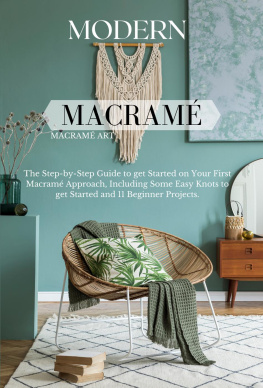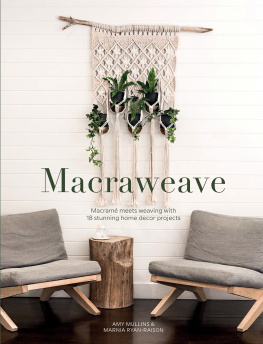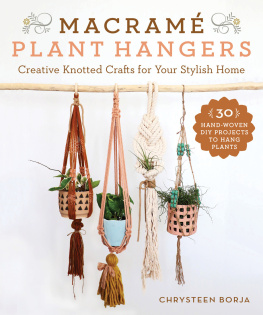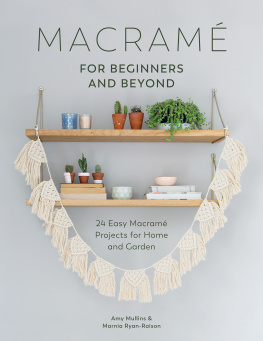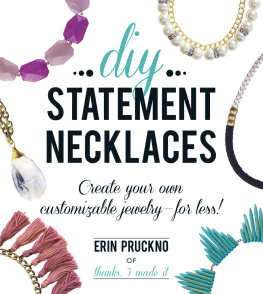Contents
Guide
CREATE STUNNING LARGE-SCALE WALL ART, HEADBOARDS, BACKDROPS AND PLANT HANGERS WITH STEP-BY-STEP TUTORIALS
STATEMENT
macram
natalieranae
MACRAM ARTIST AND INSTRUCTOR,
AUTHOR OF MACRAM AT HOME

The author and publisher have provided this e-book to you for your personal use only. You may not make this e-book publicly available in any way. Copyright infringement is against the law. If you believe the copy of this e-book you are reading infringes on the authors copyright, please notify the publisher at: http://us.macmillanusa.com/piracy.
TO EVERYONE WHO SUPPORTED MY FIRST BOOK. AND TO THE LOVE OF MY LIFE, THE MAN I WOULD NEVER WANT TO LIVE WITHOUT: SHAWN.
I truly love working on large pieces of macram. The satisfaction you get when you finally take a step back and look at what you created with your own two hands is worth all the hard work! Whenever I finish a new large-scale macram piece, I feel happy knowing that I challenged myself in a new way and learned more from the process. Turning something as ordinary as rope into a beautiful and interesting design on an impressively large scale is just so satisfying.
Over the last few years Ive taught a lot of introductory macram workshops to hundreds of students, and in every single class Ive noticed that many people were there because they aspired to make large-scale pieces. However, I would also have many people messaging me later to ask for help tackling these big projects with questions like, How long should my initial rope lengths be? or How do I even get started planning a big piece of macram? Creating large-scale or statement macram pieces is somewhat of an art form in and of itself, because it comes with a unique set of challenges and concepts that you might not encounter while making a small wall hanging or plant hanger. After many years of experience, I have figured out some techniques, tips and tricks that work well for me, and Im so excited to share them with you in this book!
Ive been fortunate to have the opportunity to create a variety of large macram pieces for a number of different purposes. Ive taken that experience and channeled it into twelve large projects in this book that can be used in homes, for special events like weddings and parties, and anywhere else you can dream up!
This book contains projects that suit different styles and skill levels, from intermediate to expert. If you already know a few macram knots and have experience creating a small macram wall hanging or plant hanger, then this is the book for you! However, if youre completely new to macram, you can still make these pieces, as I have included instructions for every knot in the . Just keep in mind that you may find things to be a bit more challenging at the beginning, as there will be a steeper learning curve. Im confident that youll succeed if you give yourself the time and take things step by step, but if you still find yourself having trouble with the projects in this book, then Id recommend picking up a copy of my first book, Macram at Home, which contains some smaller projects specifically designed for beginners.
I am so excited for you to dive into this book, and I cant wait to see your completed projects! If you post any photos on social media, please tag me so that I can see your beautiful creations! You can find me mostly on Instagram at @natalie_ranae and sometimes on Facebook at facebook.com/natalieranaehome.
have questions?
Community can be so helpful! If you ever feel stuck or have a question about a project or instruction in this book, chances are someone else might have had the same question! I always do my best to try and answer any questions, but since I am only one person I thought it would be helpful to create a Facebook group where you can post and ask questions about this book (and my last one, Macram at Home)! If you are interested in joining this group, just search Natalie Ranae Macram Book Community on Facebook and request to join!
Please respect that all of the projects and instructions in this book are my original designs. Ive created them for your personal use and kindly request that you not sell the finished products. Thank you so much for respecting my work in this way!
GETTING SET UP
My typical setup when working on macram is an adjustable clothing rack on wheels with two S hooks that hang from the rack and hold the piece. How you work on larger-scale projects really depends on the size of the piece. Youll be surprised at how much you can do on one of these clothing racks, and you can even use two or three racks lined up next to each other to support a really long piece.
Another option that I find helpful and inexpensive is using two long wall brackets designed for shelves or hanging plants. I attach them to the wall at the desired height and around 7 feet (2.1 m) or so apart and place a thick wood dowel around 8 feet (2.5 m) in length across the two brackets. I then hang the piece of macram from S hooks, or two strings tied at incremental heights. Another setup Ive used in a larger studio space is a canoe hoist pulley system typically designed for use in garages. This worked incredibly well as I could adjust the hanging height really easily and it could support the weight of a large piece, which is something you should consider when working on the projects in this book. The weight of rope can add up quickly, so keep that in mind for whatever setup youre using. Any of these setups work for alternating between standing and sitting.
BEFORE YOU START
I use a measuring tape, scissors and masking tape for every project in this book, so these wont be listed in the tools or materials section. Make sure you have them for each project. I use masking tape on the ends of most of my cords, to keep the rope from unraveling while I work.
Cut and prep most or all of your rope before starting. Its like batch workingmost of the time its easier and faster to do it all at once when youre already set up and in the flow of prepping. It can be helpful to hang the cords in half from an S hook to keep them organized. In a pinch, Ill lay them out on the floor in rows.
I like to put a dowel through the hole of the spool of rope and put that through a milk crate or over a large storage bin. This allows the spools to freely spin while cutting the rope lengths. Secure the ends of your rope by placing a piece of masking tape around the rope and cutting in the middle of the tape. This will help keep the rope from unraveling when youre pulling the cords through each knot.



